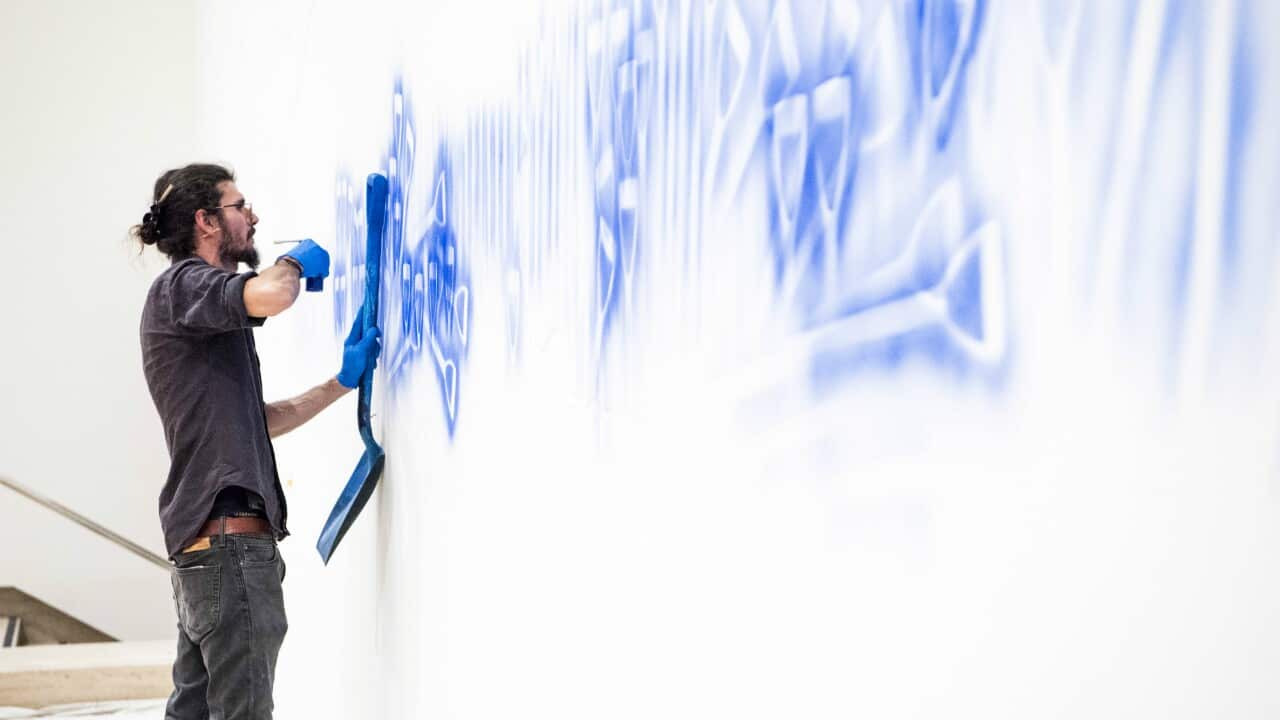Featuring more than 200 works, the Queensland Art Gallery display includes a handful of new commissions by Aboriginal and Torres Strait Islander artists.
Among them is a striking wall painting from Brisbane artist Dale Harding, a descendant of the Bidjara, Ghungalu and Garingbal peoples.
His piece, 'Wall Composition in Reckitt's Blue', uses a laundry powder to recreate traditional rock art from his ancestral home in Carnarvon Gorge.
Reckitt's Blue was a popular laundry detergent in colonial Australia during the late nineteenth century. Its natural blue pigments were unknown to Aboriginal people, who used it to paint shields, clubs and boomerangs.
For Harding, the substance also symbolises the domestic labour that generations of his female ancestors were forced into under government policy. "I choose to make paintings with Reckitt's Blue these days for multiple reasons," explains Harding.
"I choose to make paintings with Reckitt's Blue these days for multiple reasons," explains Harding.

The exhibition also features works from the gallery's existing collection, such as this provocative piece by Kamilaroi artist Richard Bell. Source: Queensland Art Gallery
"Everywhere that the colonial frontier moved, Reckitt’s Blue came with it.
"The domestic servitude of family members of mine, and across the continent saw women and young people using Reckitt's Blue."
When you think about these traumatic experiences, a couple of generations isn’t a long time to deal with that.
Aboriginal and South Sea Islander artist Daniel Boyd has also drawn on his family history to recreate an image of slaves working on Hambledon Plantation in Cairns during the late nineteenth century.
His own great-grandfather was taken from Pentecost Island in Vanuatu - one of more than 60,000 Islanders tricked or forced into becoming slave labourers in Queensland over four decades in a practice known as 'blackbirding'. "I wanted people to understand the legacy of that and how it drove the Australian economy, Queensland economy, and how the Queensland government allowed it to happen post the abolishment of slavery," Boyd tells NITV News.
"I wanted people to understand the legacy of that and how it drove the Australian economy, Queensland economy, and how the Queensland government allowed it to happen post the abolishment of slavery," Boyd tells NITV News.

Daniel Boyd's dot painting recreates an archival image of slaves working on a sugar plantation in Cairns during the late nineteenth century. Source: Queensland Art Gallery
He hopes his artwork will draw attention to this dark chapter of the state's history.
"I just kind of felt it was important for Queensland to acknowledge it properly, because it’s kind of in the background, hasn’t been acknowledged properly," he says.
"When you think about these traumatic experiences, a couple of generations isn’t a long time to deal with that, especially when you don’t have the support to deal with those traumas. So it’s important to speak about these things to analyse the treatment of the people in these histories.
"A lot of people don’t know a lot of things, and it’s up to those people to put the effort in to understand their relationship to the landscape, and that includes the original people of this landscape, and it includes people who came here to work forcibly."
The Reimagined Australian Collection will be on permanent display at the Queensland Art Gallery. Colour Theory returns on Tuesday, 3 October 2017 at 8.00pm on NITV Ch. 34
Colour Theory returns on Tuesday, 3 October 2017 at 8.00pm on NITV Ch. 34

Quandamooka artist Sonja Carmichael created this piece, Deranji Dabayil (Rocky place, healing waters): Baskets of Culture, for the collection. Source: Queensland Art Gallery

